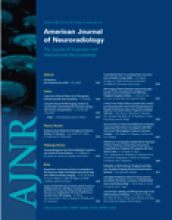Abstract
BACKGROUND AND PURPOSE: Our aim was to determine the patterns of error of radiology residents in the detection of intracranial hemorrhage on head CT examinations while on call. Follow-up studies were reviewed to determine if there was any adverse effect on patient outcome as a result of these preliminary interpretations.
MATERIALS AND METHODS: Radiology residents prospectively interpreted 22,590 head CT examinations while on call from January 1, 2002, to July 31, 2006. The following morning, the studies were interpreted by staff neuroradiologists, and discrepancies from the preliminary report were documented. Patients’ charts were reviewed for clinical outcomes and any imaging follow-up.
RESULTS: There were a total of 1037 discrepancies identified, of which 141 were due to intracranial hemorrhage. The most common types of intracranial hemorrhage that were missed were subdural and subarachnoid hemorrhage occurring in 39% and 33% of the cases, respectively. The most common location for missed subdural hemorrhage was either parafalcine or frontal. The most common location of missed subarachnoid hemorrhage was in the interpeduncular cistern. There was 1 case of nontraumatic subarachnoid hemorrhage that was not described in the preliminary report. Fourteen patients were brought back to the emergency department for short-term follow-up imaging after being discharged. We did not observe any adverse clinical outcomes that resulted from a discrepant reading.
CONCLUSION: Discrepancies due to intracranial hemorrhage are usually the result of subdural or subarachnoid hemorrhage. A more complete understanding of the locations of the missed hemorrhage can hopefully help decrease the discrepancy rate to help improve patient care.
- Copyright © American Society of Neuroradiology












